The Rise of Genderless Fashion and Its Impact on the Industry
Fashion has long been regarded as an avenue for self-expression and individuality. Over the years, the industry has witnessed a significant shift towards genderless fashion, challenging traditional notions of femininity and masculinity. This rise in genderless fashion has not only revolutionized the way we perceive clothing, but it has also had a profound impact on the fashion industry as a whole.
Genderless fashion, also known as gender-neutral or unisex fashion, focuses on breaking free from societal norms and stereotypes attached to clothing. It emphasizes inclusivity, allowing individuals to express themselves without the pressure of adhering to preconceived gender norms. As a result, genderless fashion has gained traction among people who identify beyond the binary spectrum, as well as among those who simply appreciate the idea of clothing that transcends traditional gender boundaries.
One of the most significant impacts of genderless fashion lies in its ability to challenge and dismantle traditional gender roles within the industry. Historically, fashion has perpetuated the notion that certain styles and designs are exclusive to men or women. However, genderless fashion aims to break down these barriers, offering a new way for individuals to express themselves without limitations. This shift has allowed individuals to explore their personal style without societal judgement or confinement, thereby opening up avenues for creativity and self-discovery.
Genderless fashion has also played a fundamental role in promoting inclusivity and diversity within the industry. By embracing a gender-neutral approach, fashion brands have been able to reach a broader audience and cater to customers who do not conform to societal gender norms. This has not only resulted in increased sales for brands venturing into genderless fashion, but it has also fostered a sense of acceptance and representation for marginalized communities within the fashion world.
Moreover, the rise of genderless fashion has prompted designers to reconsider their design processes. Instead of creating separate collections for men and women, many fashion houses have adopted a gender fluid approach where their designs can be worn by anyone, regardless of their gender identity. This has sparked a much-needed conversation about the inherent fluidity of fashion and the need for a more inclusive approach in the industry. By challenging traditional norms and embracing genderless fashion, designers are pushing the boundaries of creativity and expanding the possibilities within the industry.
In addition to its socio-cultural impact, genderless fashion has also proven to be financially lucrative for brands. The increasing demand for gender-neutral clothing has led to a rise in sales and profitability for companies catering to this market. Customers are no longer limited by traditional gender divisions while shopping, leading to a wider customer base and increased revenue. As a result, more and more fashion brands are incorporating genderless collections into their offerings, recognizing the potential for growth and profitability within this market segment.
The rise of genderless fashion has not come without its challenges, however. Critics argue that by eliminating gender distinctions in clothing, we run the risk of erasing the cultural significance and history behind certain garments. They fear that the unique identities and narratives associated with traditional men’s and women’s fashion will be lost in the pursuit of gender neutrality. Despite these concerns, proponents of genderless fashion argue that it is essential for the industry to evolve and adapt to the changing times, providing a platform for individuals to express themselves authentically.
In conclusion, the rise of genderless fashion has had a profound impact on the industry, challenging traditional gender roles, promoting inclusivity, and driving financial growth. By breaking free from societal norms and stereotypes, genderless fashion allows individuals to express themselves authentically without limitations. While it may face criticism for diluting the cultural significance of traditional gendered clothing, genderless fashion represents a necessary step towards a more inclusive and accepting fashion industry. As this movement continues to gain momentum, it is clear that genderless fashion is here to stay and will continue reshaping the industry for years to come.


